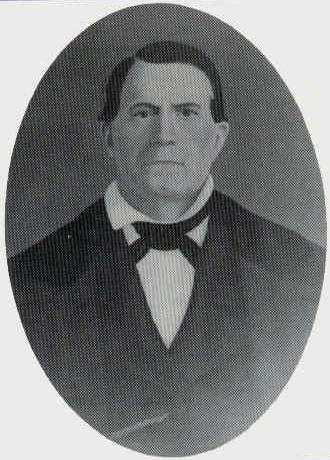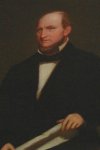CCLHP: The Lynching of Adolphus Monroe

Image of Coles County's first county clerk, Nathan Ellington.
Lupton, John. "'In View of the Uncertainty of Life': A Coles County Lynching." From Illinois Historical Journal, v.89 no3 (1996): 135.
First Lynching
The first lynching in Coles County history took place on February 18, 1856. The lynching transpired after Adolphus Monroe was convicted for the murder, of his father-in-Law, and first Coles Country Clerk, Nathan Ellington. Nathan Ellington's death was a result of an argument between himself and Adolphus Monroe. Many sources, including the newspapers from the time, speculate that a disagreement between the two led to a brutal altercation. During this fight, Adolphus Monroe pulled a pistol from his coat and fired on Mr. Ellington. Mr. Ellington died the same day, October 19, 1855, as a result of the wounds he sustained at the hands of Monroe. The trial of Adolphus Monroe concluded on January 24, 1856, when it was announced that he was to be hung for the death of his father-in-law. Two days before the hanging was to commence, a messenger from Governor Matteson arrived to delay the hanging for three months. The Newspaper accounts from the time make the case that a sizable number of people had already come to Charleston to witness the execution of Monroe. The sheriff, John R. Jeffries, printed four hundred copies of the document, sent by the Governor, which sited the reasons for the reprieve. This official document was intended only for the sheriff, not for public display. The document sent by the governor outlined the reasons why a stay was placed on the execution of Monroe. This document created a public frenzy for two reasons; one, was that the people were outraged that a guilty man, whom murdered one of the counties most respected citizens, was being show mercy by the government of the state. The second reason this event caused such a frenzy, was because it relieved the town from participating in the social activity that everyone in the county was amassing in Charleston to see. In circulating the document, the sheriff created an environment, which made it impossible to follow through with the orders handed down by the Governor.
A mob formed at the courthouse, to voice their opinions about the reprieve. At this time, the mob began amassing anger towards the decision passed down by the Governor. Speakers began voicing their opinions about what the populace should do now that the decision to disallow the hanging had been made. The general sentiment of the crowd seemed to echo the idea that the hanging should commence anyway. Both James Cunningham, son of Nathan Ellington, and brother-in-law of Adolphus Monroe, and Sheriff John Jeffries, attempted to appease the crowd that had amassed in the town square. Their speeches were unsuccessful in detouring the mob's frustration about the decision of the governor. Instead, the mob intensified their rhetoric about carrying out the hanging. It was speculated, by the newspaper accounts, that the sheriff had not intending to stop the mob from carrying out their plan to hang Adolphus Monroe. It would seem that the speech, by the Sheriff, was his effort to make it seems as though he was against the actions of the mob. In the end, the frustration and emotions of the crowd boiled over and culminated in an assault on the jail. The intention of the mob was to capture Mr. Monroe and carry out the sentence the court of their county had handed down.
All at once, the mob decided to carry out their plan to carry out justice in their town. By the time the mob decided to act their ranks, had been estimated, to be between two and three hundred people. When the mob attacked the jail, it took a long time for the people to break into the jail itself. Instead of storming the jail, the mob simply began chipping away at the wall of the cell that Mr. Monroe had been assigned to. Many sources speculate that the mob wavered in their intent to capture Mr. Monroe during this time. The time it took to actually break Monroe out of his cell was between one and two hours. During this time though, the authorities were unwilling to make an effort to stop the prisoner from escaping. Instead, armed guards were placed in the jail, not to prevent the mob from coming in, but instead, the guards were posted there in order to prevent the prisoner from escaping.
In the end, the mob succeeded in retrieving Mr. Monroe. Upon doing so, the mob took him out of the city to a near by grove of trees where he was lynched. With the deed accomplished, the mob paraded the body of Mr. Monroe around the square of Charleston in celebration of their devious act.
The first lynching of Coles County had been carried out as an act of protest against the Governor's reprieve. The people of the county did not see any need for such a continuance, in the case of Mr. Monroe. The populace of the town honestly believed that the only way to achieve justice in this case was to put Mr. Monroe to death. Anything, including a reprieve issued by the governor, was seen to be an action, which violated the beliefs of the people. The sheriff of the county had a significant role in supporting the actions of the mob. To be fair, his efforts helped raise the level of ferocity to allow the event to transpire in the first place. Circulating the Governor's reprieve could have only served in creating an atmosphere, which was conducive to upheaval. It would seem, that the actions of the mob, even though encouraged by the sheriff, were actually carried out as a way for the people of the town to voice their disdain for such a blatant disregard for their justice system. The lack of control exhibiting by the sheriff presents the possibility of this event simply being an act of revenge carried out by Mr. Jeffries. This is a likely explanation, since he exacerbated the situation, by spreading the Governor's document, and then failing to quell the mob when he had the chance. At any rate, the lynching of Adolphus Monroe is one of the most interesting and shocking events in the history of Coles County.

Governor Joel A. Matteson
This Image of Governor Matteson was retrieved from http://ilstatehouse.com/hall_of_governors.htm.
Newspaper Sources.
-
These newspaper articles have been transcribed in order to give insight into how the Lynching of Adolphus Monroe was been portrayed in the news media. These article deal with the event and the perceptions formed after the event.
Coles County Jail Register.
Coles County Jail Register located at Illinois Regional Archives Depository at Eastern Illinois University. Images were captured via digital camera.
Lynching
-
Booth Library Archives, Illinois Regional Archives Depository, Accession # 5/0109101. Coles Jail Register, vol. 1.
- This source contains some information on William Moore including age and occupation. One item of interest: under mode of discharge the register has the words "hung by mob," and the two men listed above Moore have "escaped with mob" listed as their mode of discharge.
-
Chicago Tribune, "Taken From Jail and Lynched," June 27, 1888.
- Short article on the lynching of William Moore. The article appears to be a reprint of an article that may have been published in the Charleston Tribune. Also, like the Mattoon Journal Gazette, the article professes the good character of Mary Bumgardner and the questionable character of William Moore. The views reversed in later papers.
-
Ladd, Marta Cates and Constance Schneider Kimball. Coles County History, 1876-1976: Coles County Illinois. The Charleston Mattoon Bicentennial Commission, 1976.
- Published at the same time that many local histories were, during the U.S. bicentennial, the work contains information concerning the history of Coles County agriculture, culture government and politics, education, geography, and transportation. The book does discuss details of the life of Nathan Ellington. Also the lynching of Adolphus Monroe is briefly discussed.
-
Lupton, John. "'In View of the Uncertainty of Life': A Coles County Lynching." Illinois Historical Journal, v.89 no3 (1996): 134-46.Mattoon Journal Gazette (MJG) Wilson, Charles Edward. History of Coles County Illinois. Originally part of the Coles County edition of the Cyclopedia of Illinois, published by Munsell Publishing co., Chicago, 1905.
- Adolphus Monroe was lynched after he was given a stay of execution following conviction for the murder of his father-in-law. The town Sheriff took no extra precautions to protect Monroe, and did very little to try and stop the mob.
-
MJG "A Terrible Affair!" June 29th, 1888, 1. MJG "First Coles County Clerk Murdered; Killer Lynched," September 1, 1955, sec.10, 1.
- This, the first article the Gazette published on the Moore lynching, takes up almost the entire first page of the paper, and a short description of the Monroe lynching. Although some views of this article are reversed in later editions of the Gazette there is still a wealth of useful information. The article provides a step-by-step account of the lynching from the time Moore was accused to the time the mob finished their action. Also, revealed at the end of the article is some animosity between the towns of Charleston and Mattoon.
- MJG "Tombstone has Lengthy Inscription," September 1, 1955, sec.11, p1.
-
- Both of these articles appear in the Centennial Edition of the Mattoon Journal Gazette. They cover the lynching of Adolphus Monroe as well as the life and death of Nathan Ellington.
-
MJG July 6th 1888, 1 and 4.
- On July 6th, 1888 the MJG published two small articles and two small blurbs that related to the lynching of William Moore. One of the articles is from a Shelbyville paper, and defends its citizens against allegations that members of its community were involved in the lynching of Monroe. The other article attempts to explain why the Mattoon paper originally published an article proclaiming the guilt of Moore. This is published after many people heard of the questionable character of Moore's accuser.
-
MJG "Wm. Moore's Record in Piatt County," July 13, 1888 p. 8.
- This article reproduces a letter written by a W.D. Fairbanks who employed Moore of five years in Piatt County. Fairbanks testifies to the good nature of Moore and believes that Moore "would have harmed a decent girl." Fairbanks also says that Moore came from Cairo, IL where his reputation was good. This article provides some evidence that refutes the guilt-slanted article first published in the Gazette.








